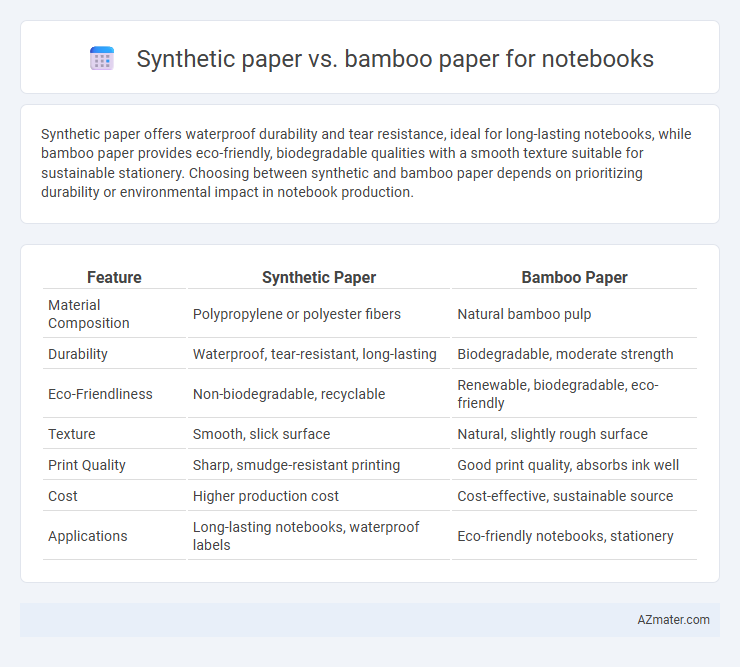Synthetic paper offers waterproof durability and tear resistance, ideal for long-lasting notebooks, while bamboo paper provides eco-friendly, biodegradable qualities with a smooth texture suitable for sustainable stationery. Choosing between synthetic and bamboo paper depends on prioritizing durability or environmental impact in notebook production.
Table of Comparison
| Feature | Synthetic Paper | Bamboo Paper |
|---|---|---|
| Material Composition | Polypropylene or polyester fibers | Natural bamboo pulp |
| Durability | Waterproof, tear-resistant, long-lasting | Biodegradable, moderate strength |
| Eco-Friendliness | Non-biodegradable, recyclable | Renewable, biodegradable, eco-friendly |
| Texture | Smooth, slick surface | Natural, slightly rough surface |
| Print Quality | Sharp, smudge-resistant printing | Good print quality, absorbs ink well |
| Cost | Higher production cost | Cost-effective, sustainable source |
| Applications | Long-lasting notebooks, waterproof labels | Eco-friendly notebooks, stationery |
Introduction: Comparing Synthetic and Bamboo Paper
Synthetic paper offers superior durability and water resistance, making it ideal for notebooks in rugged or outdoor environments. Bamboo paper is an eco-friendly alternative, known for its sustainable production and natural texture that enhances writing comfort. Both materials cater to different user preferences, balancing performance with environmental impact.
Material Composition: What Are They Made Of?
Synthetic paper is primarily made from high-density polyethylene (HDPE) or polypropylene (PP) resins, providing waterproof, tear-resistant, and durable qualities ideal for notebooks exposed to moisture. Bamboo paper, derived from the pulp of bamboo grass, boasts a natural, eco-friendly composition with strong fibers that offer sustainability and biodegradability advantages. The fundamental difference lies in synthetic paper's plastic-based formulation versus bamboo paper's organic fiber content, directly impacting their environmental footprint and texture for writing.
Environmental Impact: Sustainability and Eco-Friendliness
Synthetic paper offers durability and water resistance but is typically made from petroleum-based materials, raising concerns about its environmental footprint and biodegradability. Bamboo paper, derived from fast-growing bamboo plants, is highly sustainable, biodegradable, and requires less water and pesticides in cultivation, significantly reducing its ecological impact. Choosing bamboo paper for notebooks supports eco-friendly practices and promotes sustainability through the use of renewable, natural resources.
Durability and Water Resistance
Synthetic paper offers superior durability and exceptional water resistance compared to bamboo paper, making it ideal for notebooks used in harsh or wet environments. Bamboo paper, while eco-friendly and biodegradable, tends to absorb moisture and wear down more quickly under heavy use. Choosing synthetic paper enhances longevity and protection against water damage, crucial for maintaining notebook integrity in demanding conditions.
Writing Experience: Texture and Compatibility with Pens
Synthetic paper offers a smooth, consistent texture that enhances writing precision and is highly compatible with gel, ballpoint, and fountain pens, reducing ink bleed and feathering. Bamboo paper provides a natural, slightly rough texture that adds a tactile feel but may cause slight resistance depending on the pen type, generally performing well with standard ballpoint and pencil writing. Both materials support a variety of writing instruments, but synthetic paper excels in delivering a clean, crisp writing experience with superior ink adherence.
Cost Analysis: Price Comparison
Synthetic paper for notebooks typically costs between $0.10 and $0.30 per sheet, reflecting its durable, water-resistant properties and longer lifespan. Bamboo paper, priced around $0.05 to $0.15 per sheet, offers an eco-friendly alternative with lower production costs due to rapid bamboo growth and minimal chemical use. Despite higher upfront expenses, synthetic paper's longevity can reduce replacement frequency, while bamboo paper provides cost-effective sustainability for budget-conscious consumers.
Print Quality and Ink Absorption
Synthetic paper offers superior print quality with sharper, more vibrant images due to its smooth, non-porous surface that enhances ink adherence and prevents bleeding. Bamboo paper provides a natural texture that absorbs ink more readily, resulting in slightly muted colors and potential feathering depending on the ink type. For precise, high-definition prints, synthetic paper is preferred, while bamboo paper suits eco-friendly purposes where print sharpness is less critical.
Weight and Portability
Synthetic paper typically offers a lighter weight profile compared to bamboo paper, making it more suitable for portable notebooks that demand ease of carry. Bamboo paper, while eco-friendly and durable, tends to be heavier due to its natural fiber composition, potentially impacting the overall portability of notebooks. Selecting synthetic paper enhances travel convenience by reducing bulk, while bamboo paper prioritizes sustainability with a modest compromise on weight.
Recyclability and End-of-Life Disposal
Synthetic paper offers high durability and water resistance, but its recyclability is limited due to plastic-based materials that complicate conventional paper recycling processes. Bamboo paper, being made from natural and fast-growing bamboo fibers, is biodegradable and widely accepted in standard paper recycling streams, ensuring easier end-of-life disposal. Choosing bamboo paper promotes a more sustainable lifecycle by reducing environmental impact and supporting circular economy initiatives.
Best Use Cases for Synthetic vs Bamboo Paper Notebooks
Synthetic paper notebooks excel in environments requiring water resistance, tear-proof durability, and long-lasting archival quality, making them ideal for fieldwork, outdoor journaling, and professional use in harsh conditions. Bamboo paper notebooks are best suited for eco-conscious users seeking biodegradable, sustainable options with a natural texture that enhances writing comfort and aesthetics, making them perfect for daily note-taking, creative journaling, and casual office use. Choosing between synthetic and bamboo paper depends on needs for durability versus environmental impact, with synthetic offering unmatched resilience and bamboo providing an eco-friendly writing experience.

Infographic: Synthetic paper vs Bamboo paper for Notebook
 azmater.com
azmater.com